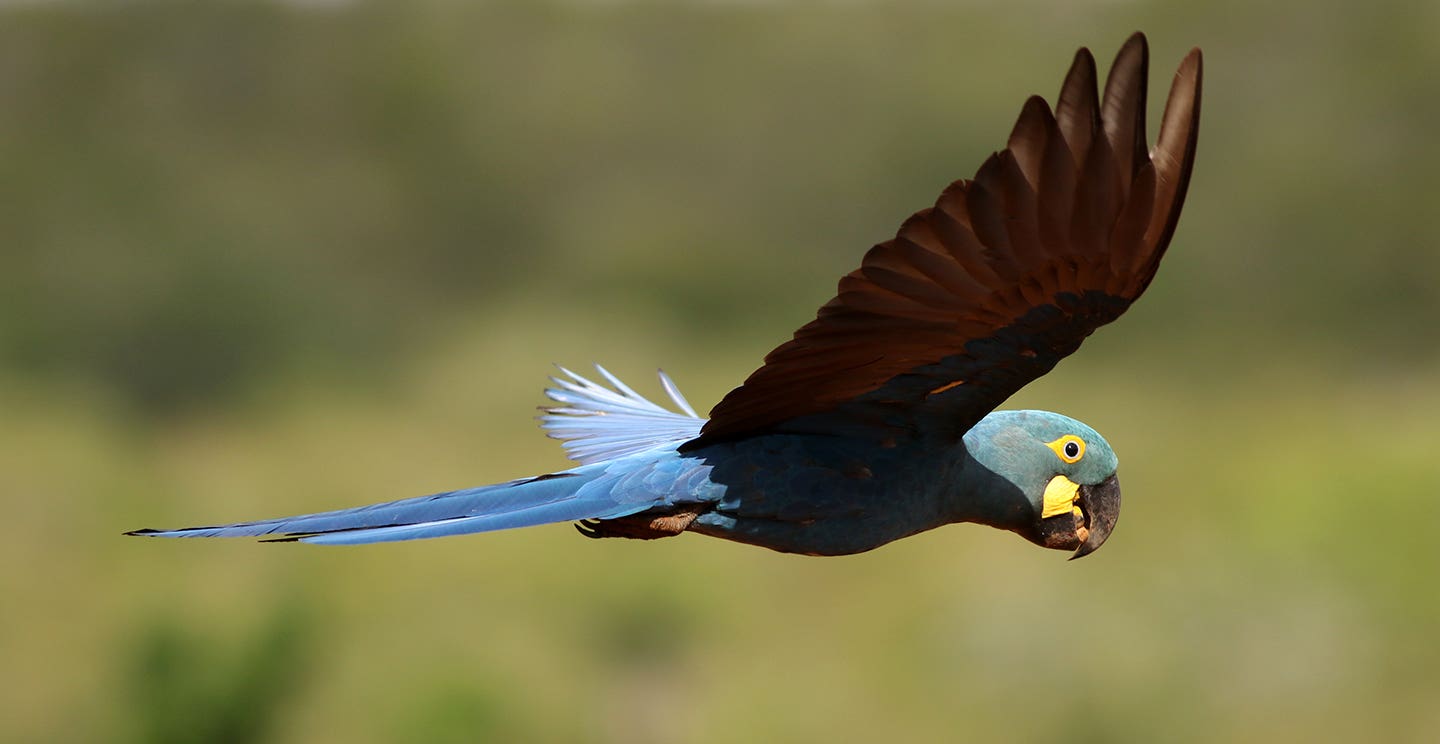In the race to mitigate the effects of climate change around the globe, support and demand for green or renewable energy is growing. According to the Global Wind Energy Council, global wind energy projects grew by 12.4% in 2021, with China, the United States, Brazil, Vietnam and the U.K., leading the way.
But in a small region in the Brazilian state of Bahia, renewable energy development in the country’s Caatinga ecoregion is stoking tension for local peoples and threatening the habitat of the Lear’s Macaw, a species of bird classified as Endangered on the IUCN Red List of Threatened Species and brought back from the brink of extinction in the past.
The bird’s habitat is in a Key Biodiversity Area (KBA), which is a place critical to the persistence of biodiversity on the planet. As a member of the KBA Partnership, Re:wild works with international and local partners to protect KBAs and their biodiversity—like the Lear’s Macaw—from extractive industry and development.
“We are very supportive of renewable alternatives to extractive energy industries, but we have to make sure that these projects are not having impacts that offset the good that they are meant to do for the planet,” says Rodrigo Medeiros, Re:wild’s senior Brazil lead. “Lear’s Macaws are a critical part of their ecosystem and their ecosystem is a critical part of the solution to the climate crisis. We welcome these kinds of wind projects in Brazil and there are so many other places these projects could be developed where they won’t pose another threat to an already Endangered species.”
For the last 10 years, concern has been brewing in this KBA over French-based Voltalia’s Canudos Wind Complex. The 99.4 MW project includes two wind farms and is in its second phase of development. Twenty-eight wind-turbine towers have already been erected over approximately six miles (10 kilometers) of shrubland and thorn forests.
The turbines pose a threat to Lear’s Macaw because the birds feed in a different place from where they roost, flying long distances to find their favorite food source, the Licuri Palm, and fatally colliding with the turbines, says Pedro Develey, a bird ecologist and executive director of SAVE Brasil, a partner of BirdLife International based in São Paulo. And when they fly in the dark at night, they are at an increased risk of collision with the turbines, even those that have been painted.
“The wind farm is in the middle of the daily route of these birds,” Develey says. “If they had moved it 100 kilometers (out of the KBA), and decided to install the towers there, they would not have had problems. There's still wind because it's the same biome, the Caatinga.”
Saved from extinction
Lear’s Macaws (Anodorhynchus leari) are large, blue-feathered parrots with bright yellow rings around their eyes. They live in the Caatinga, in the Canudos region, a geographic range comparable in size to Vancouver Island, off the West Coast of British Columbia in Canada, or the state of Maryland in the United States.
According to American Bird Conservancy, by the late 1980s, there were only 70 known Lear’s Macaws left in the wild. Over the past two decades, however, conservation efforts by Fundação Biodiversitas in Brazil, partnering with American Bird Conservancy, have brought the parrots back from the edge of extinction. The Canudos Biological Station, a 15-square-kilometer reserve that hosts scientists, birders and tourists, has been key to the species’ recovery, which now numbers over 2,000.
“It's one case of success in the conservation world,” says Develey. “That area, it’s magic, it’s unique,” he adds, noting that birders come to observe the contrast of the blue macaws against the red cliffs where they roost.
Local resistance
There has been substantial resistance to the Canudos Wind Complex over the past several years. A change.org petition started in June 2021 to stop the complex garnered nearly 85,000 signatures, and several international conservation organizations — including BirdLife International, AGIR pour la Biodiversite, American Bird Conservancy, Biodiversitas Foundation and SAVE Brasil — sent a letter to Voltalia urging the relocation of the project. In July 2021, Bahia’s state prosecution service recommended the immediate suspension of the project because Voltalia failed to undertake federally legislated environmental impact assessments and hold a public hearing with the local population.
In November 2022 local communities in the Canudos region filed a human rights complaint with the United Nations against Voltalia for its failure to follow federally legislated environmental assessments, resulting in negative impacts to communities within the region.
The complaint, made by communities in Canudos representing 600 families and signed by Re:wild and American Bird Conservancy, lists such impacts as an increase in land prices due to increased speculation, deforestation, suppression of vegetation and the fencing off of communal lands used for grazing livestock.
“The terms that were used were abbreviated so they could fit on this human-rights complaint,” said Alvaro Okura, who helped translate for the communities behind the complaint. “The threats were so extensive, we could not include them all.”
Sowing division
Aliomar Almeida (Okura’s father) is founder of Projeto Jardins da Arara de lear, a local organization protecting Lear’s Macaw through education and engagement with the traditional peoples of the area. He said the most concerning aspect of the development project is the division the company has caused within Canudos, a small city of over 15,000, that includes rural communities.
“The climate is tense,” says Almeida, who worked in the construction industry in São Paolo before retiring to Canudos 10 years ago. He described Canudos as a region that has only recently been exposed to energy development and the changes it brings, which makes it vulnerable to influence.
“The discourse of the company has been on development, on green energy, on future, on progress, on economic gains,” says Almeida. “They are doing a huge effort to hide all the technical, legal issues that they've not been complying with.”
Before the courts
A joint-action lawsuit by state and federal prosecutors against Voltalia was filed on March 22, 2023, and in April a federal judge suspended the company’s permit, until proper environmental assessment, including impacts to Lear’s Macaw, has been done. Voltalia has appealed the decision, stating that it was granted proper authority by Bahia’s environmental agency in 2020.
A judge has since authorized Voltalia to resume construction but is still requiring a proper Environmental Impact Assessment (EIA) in addition to a robust public hearing process about the project. So far the company has not held any public meetings, and additional lawsuits against the company are mounting.
In the meantime, Develey says, Voltalia is undertaking studies and meeting with conservation organizations concerned about the project to demonstrate there is little risk to the macaws, something he says is impossible to do without turning the turbines on and waiting to see how many birds collide with them.
“It’s an Endangered bird,” he stresses, pointing out that no matter how many models of low impact the company shows him in order to alleviate his fears, it’s still too big a risk. “Models are models. We know there are lots of variables they are not controlling. It's a biological system.”
In a press release about its appeal, Voltalia states that it is investing in a protected nesting area for Lear’s Macaw. While creating such a protected area is a positive step for the company, Develey says, it won’t reduce the risk the project still poses to the Lear’s Macaw. He’s also seen no action on the part of the company to do so.
For those working to protect Lear’s Macaw and its habitat, Almeida says, it feels like an “attack from all sides.” It’s hard to stand up for the bird, for the biodiversity and the bioma without being seen as an obstacle to economic developments, he says.
“The problem is not the wind projects, it's how it's done and where it's done and who they affect,” he says. “These should not be overruled simply by the desire of clean energy.”
Almeida predicts the case will go to Brazil’s Supreme Court and is optimistic that under the government of Luiz Inacio Lula da Silva, the Lear’s Macaw has better chances to remain protected.
“It's impossible to win all the environmental struggles, but you have to keep on going, you have to go forward always,” he says.
Katie Doke Sawatzky is a journalist originating from and living on the dwindling Canadian Prairie, in Treaty 4 territory and the homeland of the Métis. Her multimedia project prairiecommons.ca examined the state of native prairie in Saskatchewan, its biodiversity, and its public and spiritual value. She is based in Regina.




